Optometry Referral Letter
[Your Name]
[Your Title]
[Your Clinic/Hospital Name]
[Address]
[City, State, ZIP Code]
[Email Address]
[Phone Number]
[Date]
[Referring Doctor's Name]
[Referring Doctor's Title]
[Referring Clinic/Hospital Name]
[Address]
[City, State, ZIP Code]
Dear Dr. [Referring Doctor's Last Name],
Re: Optometry Referral for [Patient's Full Name]
Date of Birth: [Patient's Date of Birth]
Gender: [Patient's Gender]
Medical Record Number: [Patient's MRN]
I hope this letter finds you well. I am writing to refer my patient, [Patient's Full Name], for a comprehensive optometry evaluation and management of their ocular health concerns. The patient's history and current clinical presentation suggest the need for specialized optometric assessment and intervention.
Brief Patient History:
[Provide a concise overview of the patient's relevant medical history, ocular symptoms, and any previous optometric or ophthalmologic interventions.]
Reason for Referral:
[Specify the specific reason for the referral, such as suspected ocular pathology, refractive error assessment, contact lens fitting, visual field assessment, etc.]
Clinical Findings:
[Summarize any pertinent clinical findings or diagnostic test results that have led to the decision to refer the patient for optometric evaluation.]
Treatment/Management So Far:
[Outline any treatments or interventions you have initiated or recommended for the patient's ocular condition.]
Referral Details:
I kindly request that you perform a thorough optometric evaluation of [Patient's Full Name] and provide appropriate management and treatment as necessary. Please keep me informed of the evaluation results and recommended treatment plan, as this will help ensure comprehensive and coordinated care for the patient.
Patient Contact Information:
Patient's Address: [Patient's Address]
Patient's Phone: [Patient's Phone Number]
Patient's Email: [Patient's Email Address]
Please do not hesitate to contact me at [Your Phone Number] or [Your Email Address] if you require any further information or if there are any specific aspects of the patient's history that you would like to discuss before the evaluation.
Thank you for your attention to this referral, and I appreciate your collaboration in the care of this patient. I look forward to receiving your evaluation results and recommendations.
Sincerely,
[Your Signature]
[Your Printed Name]
[Your Medical License Number]
[Your Clinic/Hospital Stamp, if applicable]
CC: [Patient's Primary Care Physician, if applicable]
[Other Relevant Healthcare Providers, if applicable]
General Optometry Referral Letter
Dear Dr. [Ophthalmologist/Specialist Name],
I am writing to refer my patient, [Patient Name], DOB: [Date of Birth], for further evaluation and management of [specific condition/concern].
During a comprehensive eye examination on [Date], I observed [detailed findings]. The patient's visual acuity was [measurements], and [additional test results]. Based on these findings, I believe [Patient Name] would benefit from your specialized assessment for [specific reason].
The patient's relevant medical history includes [conditions, medications, allergies]. Current ocular medications include [list medications if applicable].
I would greatly appreciate your expert opinion regarding [specific questions or concerns]. Please feel free to contact me at [phone/email] if you require any additional information.
Thank you for your attention to this matter.
Sincerely,
[Your Name], OD
[Practice Name]
[Contact Information]
Urgent Retinal Detachment Referral Letter
URGENT REFERRAL
Dear Dr. [Ophthalmologist Name],
I am referring [Patient Name], DOB: [Date of Birth], for immediate evaluation of suspected retinal detachment.
CLINICAL FINDINGS: Patient presented today with sudden onset of [flashes, floaters, visual field loss]. Dilated fundus examination revealed [specific findings: retinal tear location, extent of detachment, vitreous hemorrhage]. Visual acuity: [measurements]. IOP: [measurements].
This patient requires urgent surgical consultation. I have advised the patient of the serious nature of this condition and the need for immediate specialist care.
Patient contact: [Phone Number]
Time of examination: [Time]
Please contact me immediately at [Your Phone] if you need any additional information.
Urgent regards,
[Your Name], OD
[Contact Information]
Glaucoma Suspect Referral Letter
Dear Dr. [Ophthalmologist Name],
I am referring [Patient Name], DOB: [Date of Birth], for glaucoma evaluation and management recommendations.
FINDINGS: During routine examination on [Date], I noted the following concerning features: IOP of [measurements], cup-to-disc ratio of [measurements], [additional findings such as optic nerve hemorrhages, visual field defects, pachymetry readings].
Risk factors include: [family history, age, ethnicity, myopia, etc.]. The patient is currently not on any glaucoma medications.
I would appreciate your assessment regarding the need for treatment initiation and recommendations for monitoring frequency.
Thank you for your expertise.
Best regards,
[Your Name], OD
[Practice Name]
[Contact Information]
Cataract Surgery Referral Letter
Dear Dr. [Ophthalmologist Name],
I am pleased to refer [Patient Name], DOB: [Date of Birth], for cataract surgery consultation.
EXAMINATION FINDINGS: The patient is experiencing [symptoms: decreased vision, glare, difficulty with night driving]. Best corrected visual acuity is [measurements]. Slit lamp examination reveals [grade and type] cataracts in both eyes. The posterior segment appears healthy with no contraindications to surgery.
Biometry measurements: [if available]. The patient has realistic expectations and is motivated to proceed with surgical intervention.
Relevant medical history: [diabetes, medications, previous eye surgeries]. The patient is particularly interested in [premium IOL options/standard surgery].
Thank you for your surgical expertise.
Warm regards,
[Your Name], OD
[Practice Name]
[Contact Information]
Pediatric Vision Problem Referral Letter
Dear Dr. [Pediatric Ophthalmologist Name],
I am referring [Child's Name], DOB: [Date of Birth], age [Age], for specialized pediatric evaluation and management.
CONCERNS: During examination on [Date], I identified [strabismus, amblyopia, significant refractive error, etc.]. The child's visual acuity was [measurements with appropriate testing method]. Cover test revealed [findings]. Cycloplegic refraction showed [measurements].
Parents report [developmental concerns, behavioral observations, school performance issues]. Family history includes [relevant information].
Given the critical period for visual development, I believe early intervention under your care would be beneficial. The parents are aware of the importance of prompt treatment.
Thank you for your pediatric expertise.
Kind regards,
[Your Name], OD
[Practice Name]
[Contact Information]
Diabetic Retinopathy Follow-up Referral Letter
Dear Dr. [Retinal Specialist Name],
I am referring [Patient Name], DOB: [Date of Birth], for evaluation of progressive diabetic retinopathy.
PROGRESSION NOTED: Compared to my previous examination on [Date], the patient now shows [specific changes: new hemorrhages, exudates, neovascularization, macular edema]. Current visual acuity: [measurements]. OCT imaging reveals [findings if available].
Systemic control: HbA1c [value], blood pressure [measurements]. The patient is under the care of [PCP/Endocrinologist Name] for diabetes management.
I am concerned about the progression and believe the patient may benefit from [anti-VEGF therapy, laser treatment, closer monitoring]. I will continue co-management as recommended.
Thank you for your expertise in managing this patient.
Professionally,
[Your Name], OD
[Practice Name]
[Contact Information]
Dry Eye Specialist Referral Letter
Dear Dr. [Specialist Name],
I am referring [Patient Name], DOB: [Date of Birth], for advanced dry eye disease management.
CLINICAL PICTURE: Despite conservative management including [list treatments tried: artificial tears, warm compresses, omega-3 supplements, prescription drops], the patient continues to experience significant symptoms affecting quality of life. TBUT: [measurements], Schirmer testing: [results], meibomian gland assessment: [findings].
The patient reports [impact on daily activities, work, driving]. I believe [Patient Name] would benefit from advanced therapeutic options such as [IPL, LipiFlow, autologous serum, etc.].
Relevant history includes [autoimmune conditions, medications, previous treatments]. The patient is motivated to pursue advanced treatment options.
Thank you for your specialized care.
Respectfully,
[Your Name], OD
[Practice Name]
[Contact Information]
Corneal Disease Referral Letter
Dear Dr. [Corneal Specialist Name],
I am referring [Patient Name], DOB: [Date of Birth], for evaluation and management of [corneal condition].
PRESENTATION: Patient presented with [symptoms: pain, redness, decreased vision, photophobia]. Slit lamp examination revealed [detailed corneal findings: infiltrate location/size, epithelial defect, stromal involvement, anterior chamber reaction]. Visual acuity: [measurements]. IOP: [measurements].
I have initiated treatment with [medications] and [Patient Name] has been using [current regimen]. However, [reason for referral: lack of improvement, progression, complexity requiring specialist care].
Cultures/smears performed: [if applicable]. The patient understands the serious nature of this condition.
I would appreciate your expert management and recommendations.
Thank you,
[Your Name], OD
[Practice Name]
[Contact Information]
What is an Optometry Referral Letter and Why is it Important?
An optometry referral letter is a formal professional communication from an optometrist to an ophthalmologist or specialized eye care provider, requesting evaluation, treatment, or co-management of a patient's ocular condition. This document serves several critical purposes:
- Continuity of Care: Ensures seamless transition of patient information between providers, maintaining comprehensive care standards
- Legal Documentation: Creates a paper trail demonstrating appropriate standard of care and clinical decision-making
- Professional Communication: Establishes collaborative relationships between primary eye care providers and specialists
- Patient Safety: Expedites appropriate treatment by providing specialists with essential background information
- Insurance Requirements: Many insurance plans require formal referrals for specialist reimbursement
- Scope of Practice: Demonstrates appropriate recognition of conditions requiring specialist intervention beyond optometric management
When Should You Send an Optometry Referral Letter?
Referral letters become necessary in numerous clinical scenarios:
- Surgical Intervention Needed: Cataracts affecting quality of life, pterygium requiring excision, refractive surgery candidates
- Sight-Threatening Emergencies: Retinal detachment, acute angle-closure glaucoma, endophthalmitis, temporal arteritis
- Progressive Disease: Worsening glaucoma despite treatment, advancing diabetic retinopathy, progressive keratoconus
- Diagnostic Uncertainty: Unexplained vision loss, atypical presentations, complex pathology requiring advanced imaging
- Specialized Treatment Required: Anti-VEGF injections, laser procedures, specialized contact lens fitting, complex dry eye management
- Pediatric Concerns: Amblyopia requiring intensive treatment, congenital abnormalities, pediatric glaucoma
- Medical-Ocular Conditions: Thyroid eye disease, uveitis requiring systemic workup, neuro-ophthalmic conditions
- Treatment Failure: Conditions not responding to primary care management protocols
- Second Opinion Requests: Patient desires specialist consultation for treatment options or confirmation of diagnosis
Who Should Write and Send Optometry Referral Letters?
The referring optometrist bears responsibility for creating and transmitting the referral letter:
- Licensed Optometrists: Primary eye care providers who identify conditions requiring specialist care
- Optometrists in Various Settings: Private practice, retail clinics, hospital-based practices, academic institutions
- Student Doctors: Under supervision, students may draft referrals reviewed and signed by supervising optometrists
- Practice Staff Role: Administrative staff may assist with formatting and transmission but clinical content must come from the examining doctor
- Telemedicine Providers: Optometrists conducting virtual examinations who identify referral-worthy conditions
- Professional Responsibility: The referring doctor maintains responsibility for ensuring the referral is sent and received, regardless of who physically transmits it
To Whom Should Optometry Referral Letters Be Addressed?
The recipient of your referral letter depends on the specific clinical situation:
- General Ophthalmologists: Cataracts, routine surgical needs, general eye disease management
- Retinal Specialists: Diabetic retinopathy, retinal detachment, macular degeneration, vitreoretinal diseases
- Glaucoma Specialists: Complex glaucoma cases, surgical glaucoma management, difficult-to-control pressures
- Corneal Specialists: Keratoconus, corneal infections, corneal transplant evaluation, complex contact lens issues
- Pediatric Ophthalmologists: Strabismus, amblyopia, congenital conditions, childhood eye diseases
- Neuro-Ophthalmologists: Visual field defects, optic nerve disease, double vision, neurological vision problems
- Oculoplastic Surgeons: Eyelid malposition, orbital disease, lacrimal system disorders, cosmetic concerns
- Ocular Oncologists: Suspicious intraocular masses, eyelid tumors, conjunctival lesions requiring biopsy
- Low Vision Specialists: Patients with irreversible vision loss requiring rehabilitation services
Essential Elements and Structure of Optometry Referral Letters
A comprehensive referral letter should include specific components in a logical sequence:
- Patient Demographics: Full name, date of birth, contact information, medical record number if applicable
- Date of Examination: When findings were observed, timestamp for urgent referrals
- Chief Complaint: Patient's primary concern in their own words
- Clinical Findings: Objective measurements including visual acuity, intraocular pressure, specific examination findings with anatomical details
- Diagnostic Testing Results: OCT, visual fields, imaging studies, laboratory work if relevant
- Relevant Medical History: Systemic conditions affecting eyes, current medications, allergies, previous surgeries
- Reason for Referral: Clear statement of what you're asking the specialist to evaluate or manage
- Specific Questions: What you hope the specialist will address or clarify
- Urgency Level: Clearly indicate if routine, urgent, or emergent referral
- Current Treatment: Medications or management already initiated
- Your Contact Information: Phone, fax, email for follow-up communication
- Professional Signature: Your credentials, license number if required, practice information
How to Write an Effective Optometry Referral Letter
The process of creating a strong referral letter involves systematic approach:
- Review Clinical Findings: Gather all relevant examination data, measurements, and imaging before writing
- Use Professional Language: Medical terminology appropriate for specialist-to-specialist communication, avoid casual phrasing
- Be Specific and Objective: Include precise measurements, anatomical descriptions, quantifiable data rather than vague descriptions
- Organize Chronologically: Present information in logical sequence from history through examination to impression
- State Clear Purpose: Explicitly indicate why you're referring and what you hope to achieve
- Include Supporting Data: Reference specific test results, imaging findings, previous treatment responses
- Consider Urgency: Match letter format and transmission method to clinical urgency
- Proofread Carefully: Errors undermine professional credibility and may lead to miscommunication
- Use Templates Wisely: Customize templates for each patient rather than sending generic letters
- Document in Patient Record: Keep copy of referral letter in patient's chart for continuity
Formatting Guidelines for Optometry Referral Letters
Proper formatting ensures your referral is professional and effective:
- Length: Typically one page; complex cases may require additional page but avoid unnecessary verbosity
- Professional Letterhead: Include your practice name, address, credentials, license number
- Font and Spacing: Use readable fonts (Times New Roman, Arial) in 11-12 point size with appropriate spacing
- Tone: Professional and collegial; avoid overly casual or unnecessarily formal language
- Paragraph Structure: Use short paragraphs for readability; organize information logically
- Bullet Points: Acceptable for listing findings or test results in certain sections
- Transmission Method: Email for routine referrals, fax or phone call for urgent cases, direct phone contact for emergencies
- Subject Line: For emails, use clear subject indicating patient name and urgency level
- Confidentiality: Use secure transmission methods complying with HIPAA regulations
- Response Request: Indicate if you desire written response or consultation report
- Standard vs. Custom: Balance efficiency of templates with need for individualized clinical details
Requirements and Prerequisites Before Sending Referral Letters
Several steps must be completed before transmitting your referral:
- Patient Consent: Obtain permission to share protected health information with specialist
- Insurance Verification: Confirm patient's insurance accepts referrals and covers specialist visits
- Complete Documentation: Ensure examination findings are fully recorded in patient chart
- Specialist Selection: Verify specialist accepts patient's insurance and is appropriate for condition
- Contact Information Accuracy: Confirm current specialist contact details including preferred transmission method
- Medical Records: Prepare relevant test results, imaging, previous consultation reports to send with referral
- Patient Education: Explain to patient why referral is necessary and what to expect
- Appointment Coordination: For urgent cases, call specialist office to arrange timely appointment
- Authorization Forms: Complete any insurance pre-authorization requirements
- Release Forms: Obtain signed HIPAA release if not already on file
What to Do After Sending Your Referral Letter
Post-referral responsibilities ensure continuity of care:
- Confirm Receipt: Verify specialist received referral within appropriate timeframe
- Patient Follow-Up: Contact patient to ensure they scheduled and attended specialist appointment
- Request Consultation Report: Ask specialist to send findings and management recommendations
- Review Specialist's Recommendations: Carefully read consultation report when received
- Implement Co-Management Plan: Follow specialist's recommendations for ongoing care
- Continue Monitoring: Schedule appropriate follow-up examinations based on specialist's timeline
- Document Communication: Keep all correspondence in patient's medical record
- Update Patient Records: Note specialist's diagnosis, treatment plan, and prognosis in your records
- Maintain Open Communication: Reach out to specialist if questions arise about recommendations
- Patient Education: Discuss specialist's findings with patient and reinforce treatment importance
- Insurance Follow-Up: Ensure referral was properly processed for billing purposes
Common Mistakes to Avoid When Writing Referral Letters
Awareness of frequent errors improves referral quality:
- Vague Descriptions: Using non-specific terms like "abnormal" without detailed findings
- Missing Key Information: Omitting visual acuity, IOP, or other essential measurements
- Unclear Referral Reason: Failing to explicitly state what you want specialist to address
- Inappropriate Urgency: Not matching transmission speed to clinical urgency level
- Excessive Medical Jargon: Overcomplicating straightforward presentations
- Inadequate History: Leaving out relevant medical or ocular history
- No Contact Information: Forgetting to include your phone number or email
- Generic Templates: Sending obviously templated letters without patient-specific details
- Poor Organization: Presenting information in confusing or illogical sequence
- Typos and Errors: Patient name misspellings, incorrect dates, wrong measurements
- Missing Follow-Up Request: Not indicating you want consultation report returned
- Delayed Transmission: Waiting too long to send urgent referrals
- HIPAA Violations: Using unsecured email or fax for sensitive information
Advantages and Disadvantages of Formal Referral Letters
Understanding pros and cons helps optimize referral process:
Advantages:
- Creates comprehensive documentation trail protecting both providers legally
- Ensures specialist has complete background information for informed decision-making
- Demonstrates professional standard of care and appropriate clinical judgment
- Facilitates insurance authorization and reimbursement processes
- Strengthens professional relationships between referring and receiving providers
- Improves patient outcomes through coordinated, informed care
- Reduces redundant testing by providing previous results
Disadvantages:
- Time-consuming to write detailed, individualized letters
- May delay urgent care if written referral required before appointment scheduling
- Risk of information being lost, misfiled, or not reviewed by receiving provider
- Creates additional administrative burden on staff for transmission and follow-up
- May not capture all nuances better communicated via direct phone conversation
- Potential for miscommunication if letter unclear or misinterpreted
- Requires follow-up to ensure receipt and response, adding to workload
Comparing Optometry Referral Letters to Alternative Communication Methods
Different communication approaches serve varying purposes:
Written Referral Letter vs. Phone Consultation:
- Letters provide permanent documentation; phone calls may not be recorded
- Phone allows immediate clarification and discussion; letters are one-way communication
- Emergency situations warrant phone calls; routine referrals suit written format
Formal Letter vs. Electronic Health Record Referral:
- EHR referrals integrate seamlessly into shared systems but require compatible platforms
- Traditional letters work across all systems but may not integrate automatically
- EHR allows real-time tracking; letters require manual follow-up
Detailed Letter vs. Brief Referral Form:
- Comprehensive letters suit complex cases requiring extensive background
- Brief forms suffice for straightforward situations like routine cataract referrals
- Forms standardize information but may miss important unique details
Optometry Referral vs. Self-Referral:
- Optometry referrals provide specialist with clinical context and examination findings
- Self-referrals require specialist to start evaluation from beginning
- Insurance often requires formal referral rather than patient-initiated appointments
Expert Tips and Best Practices for Referral Letters
Professional insights enhance referral effectiveness:
- Use SBAR Format: Situation, Background, Assessment, Recommendation structure improves clarity
- Lead with Urgency: For urgent cases, state "URGENT" prominently at top of letter
- Be Collegial: Remember you're communicating with fellow professionals; maintain respectful tone
- Include Images: When appropriate, attach photos or imaging studies with written findings
- Quantify Everything: Use numbers, measurements, grades rather than subjective descriptions
- State the Obvious: Don't assume specialist knows why you're referring; be explicit
- Request Specific Feedback: Ask particular questions rather than general "please evaluate"
- Use Their Preferred Method: Learn specialists' preferred communication channels and use them
- Build Relationships: Referrals strengthen professional networks; maintain good rapport
- Follow Up Promptly: Don't let referrals languish without confirmation of receipt and action
- Educate Patients: Explain referral process so patients know what to expect and why it matters
- Keep Templates Updated: Regularly review and revise templates based on feedback received
- Proofread Multiple Times: Fresh eyes catch errors; review before sending
Frequently Asked Questions About Optometry Referral Letters
How quickly should I send urgent referrals? Same-day for sight-threatening emergencies, with phone call to specialist office to ensure immediate attention.
Do I need patient signature on referral letters? Not on the letter itself, but you need signed HIPAA release allowing information sharing.
What if specialist doesn't send consultation report? Follow up with phone call or email requesting report for your records and co-management.
Should I send test results separately? Include key findings in letter; send actual reports/images as attachments or separate transmission.
Can I refer to out-of-network specialists? Yes, but inform patient of potential insurance implications and out-of-pocket costs.
How long should patients wait for specialist appointments? Depends on urgency: emergent same-day, urgent within week, routine within month.
What if I disagree with specialist's recommendations? Discuss concerns professionally with specialist; patient's best interest should guide final decisions.
Should I continue treating patient while awaiting specialist visit? Yes, maintain current management unless specialist advises otherwise, especially for ongoing conditions.

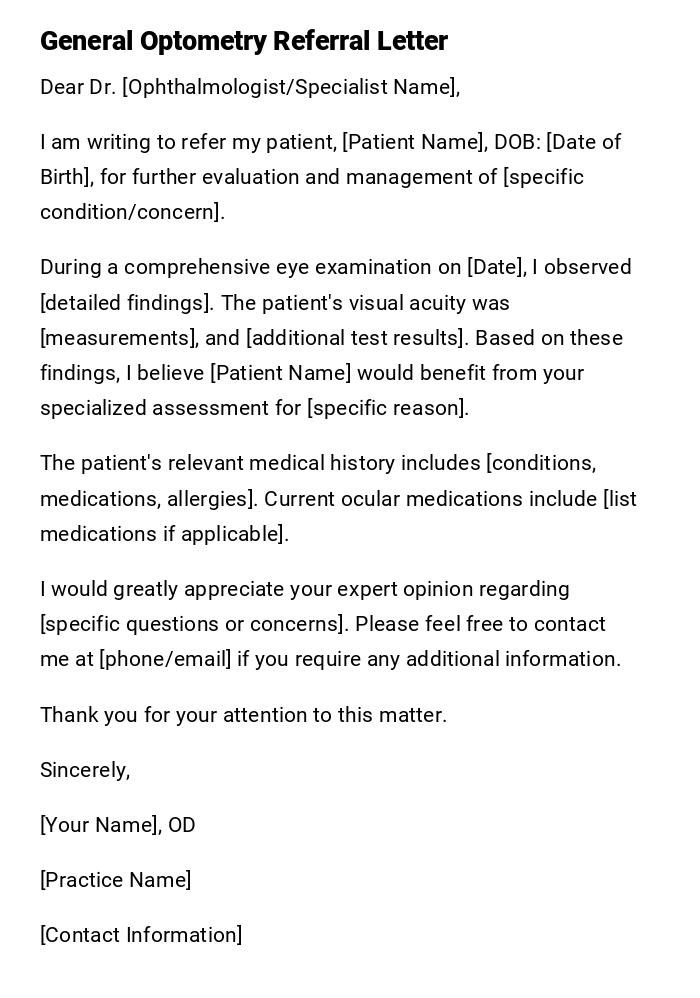
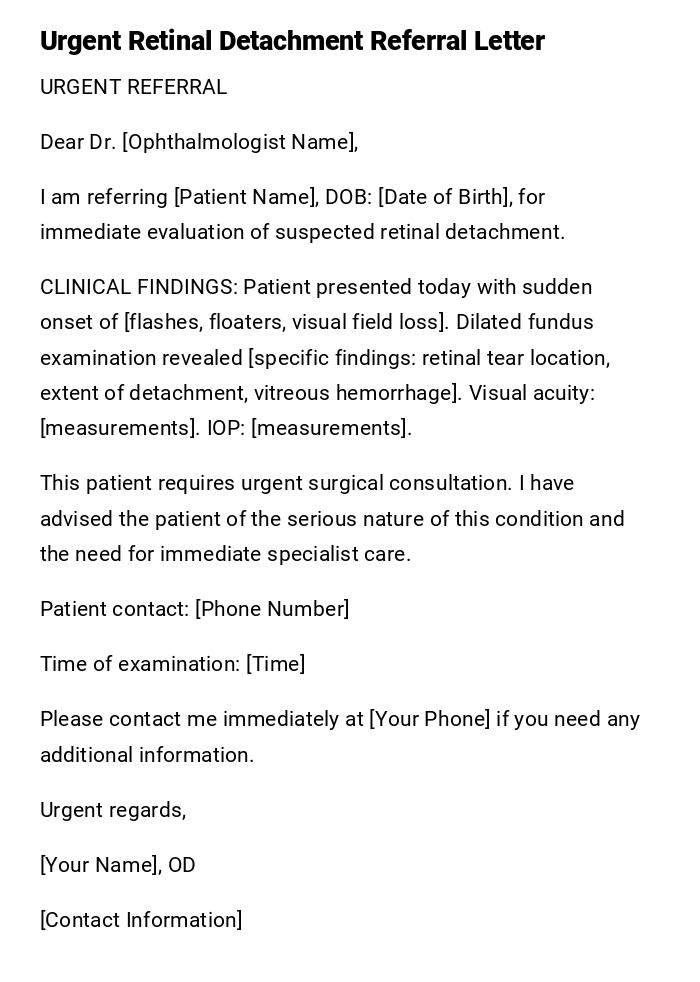
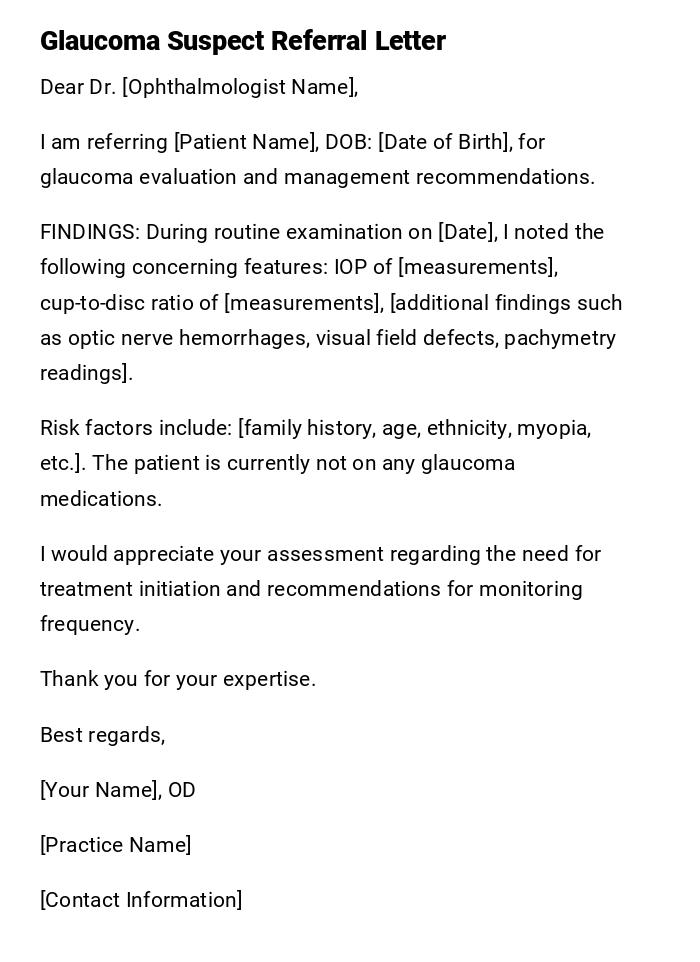
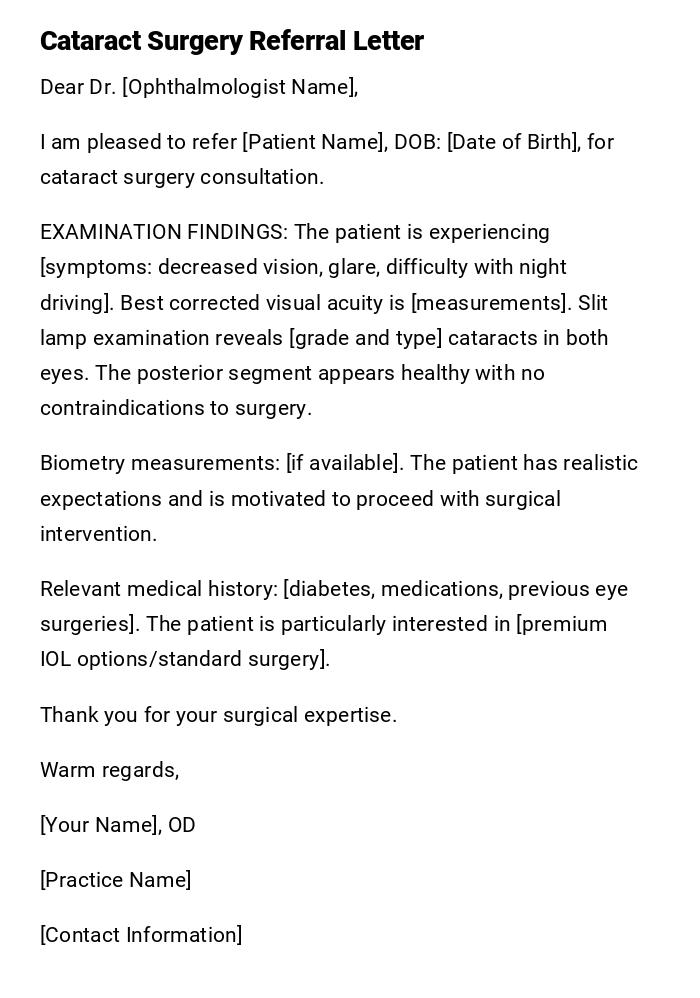
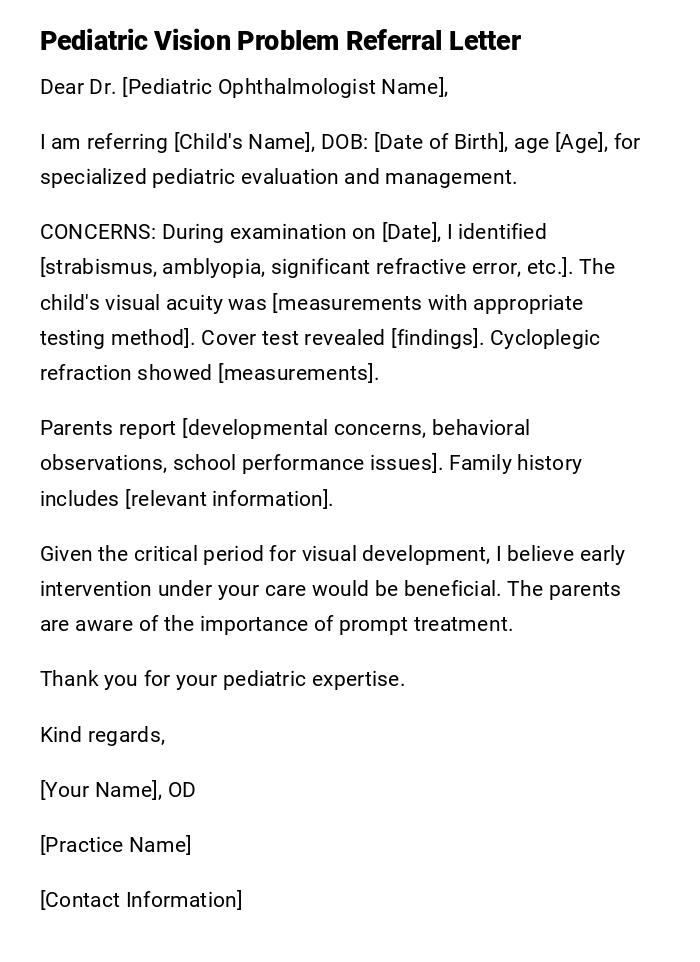
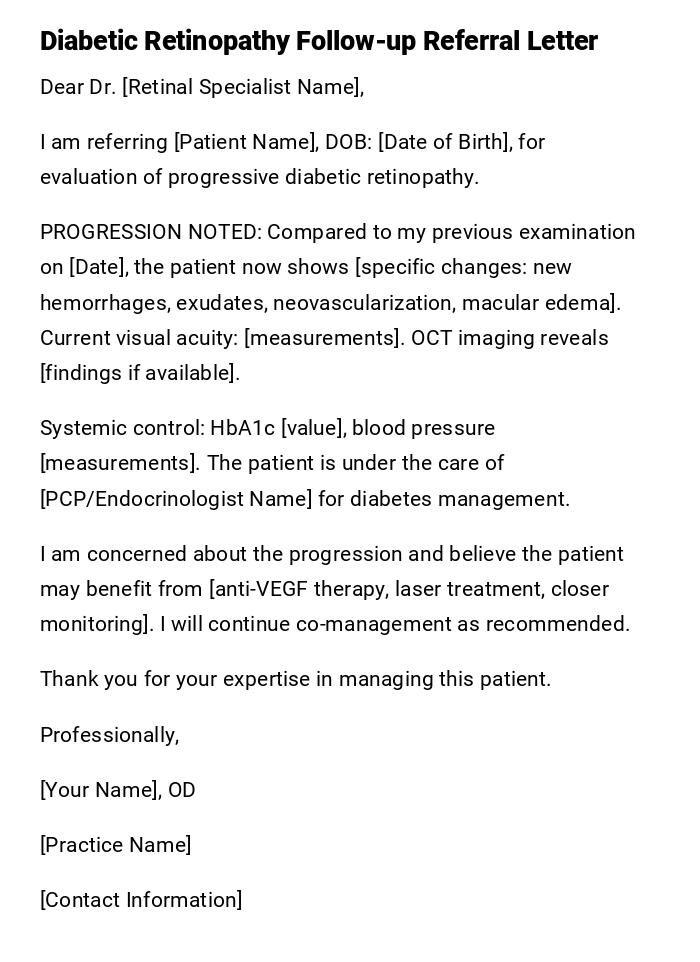
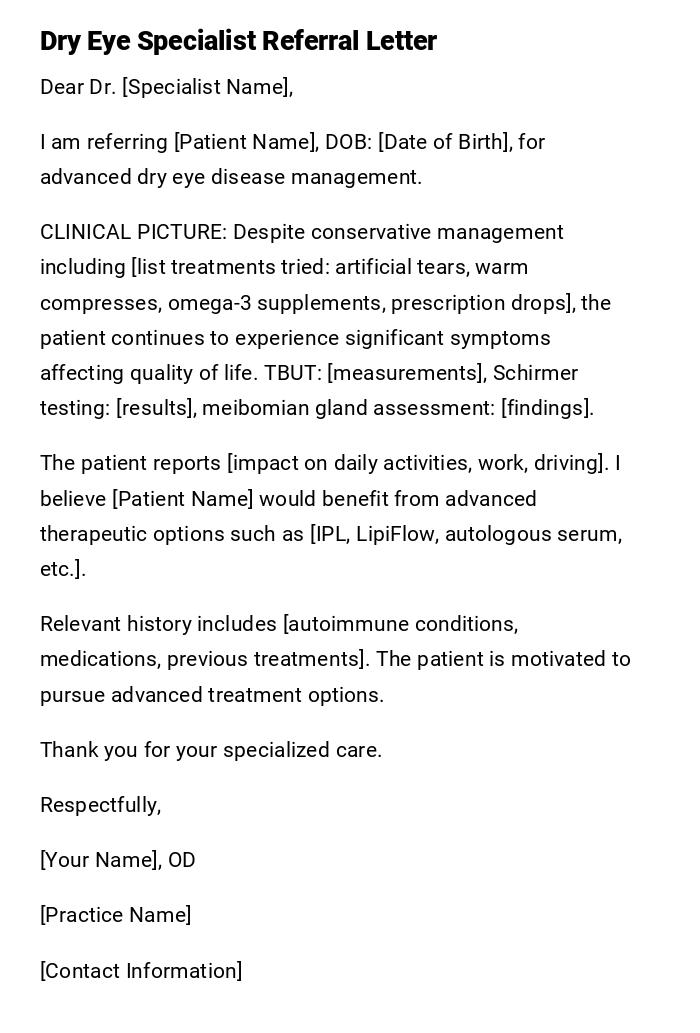
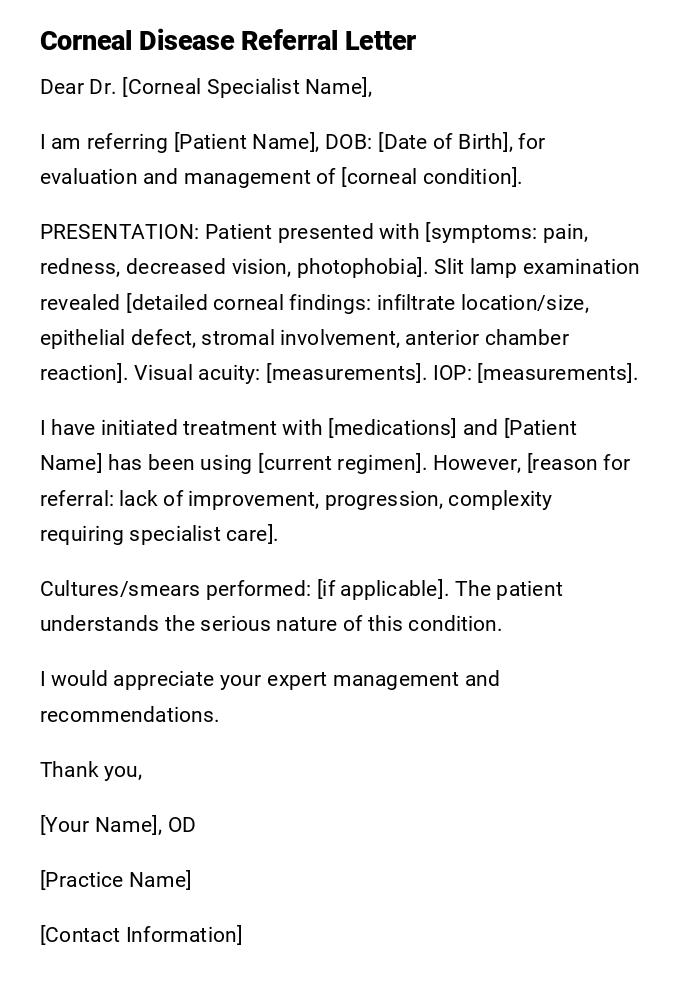

 Download Word Doc
Download Word Doc
 Download PDF
Download PDF